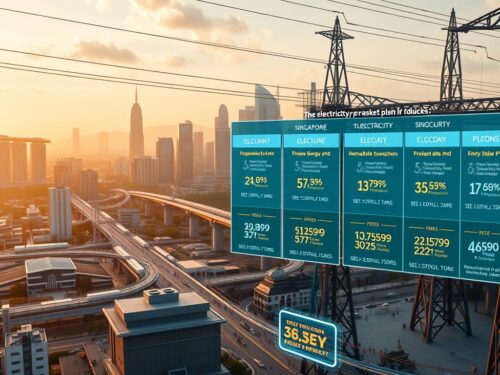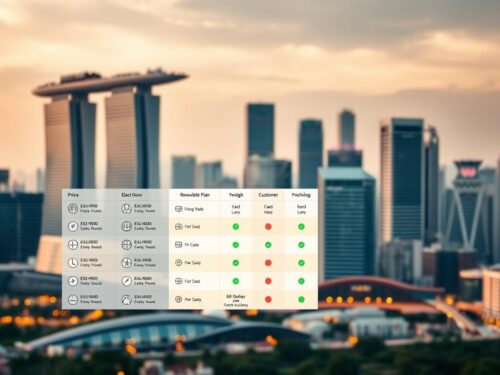Singapore’s energy market has become highly competitive since the launch of the Open Electricity Market (OEM). This shift allows consumers to explore various options and save significantly on their monthly bills. By switching from the SP Group, households can reduce costs by 20-30%, making it a smart financial move.
When choosing a provider, consider factors like contract length, plan types, and hidden fees. Retailers such as Geneco, PacificLight, and Tuas Power offer attractive promotions and referral bonuses, especially in 2021. For example, a typical 4-room HDB flat can save between $6-$15 per month with OEM plans.
Understanding Q1 2021 tariff rates (28.12¢/kWh before GST) and using comparison tools from SP Services and DBS can help you make an informed decision. Stay tuned as we dive deeper into plan types and cost comparisons in the upcoming sections.
Key Takeaways
- Switching providers can save you 20-30% on monthly bills.
- Compare contract lengths, plan types, and hidden fees.
- Top retailers include Geneco, PacificLight, and Tuas Power.
- 2021 promotions and referral bonuses offer extra savings.
- Use comparison tools for better decision-making.
Introduction to the Open Electricity Market (OEM) in Singapore
The Open Electricity Market (OEM) has transformed how households manage their energy needs. Launched nationwide in May 2019, following a successful pilot in Jurong, this initiative by the Energy Market Authority (EMA) allows consumers to choose their preferred retailers. This shift from the SP Group’s regulated tariffs has introduced competition, offering better rates and services.
What is the Open Electricity Market?
The OEM is a consumer choice initiative announced in 2017. Before its introduction, only corporate clients had access to competitive rates. Now, residential consumers can also benefit from market liberalization. This means you’re no longer limited to the SP Group’s regulated rates, which were higher compared to OEM offerings.
For example, in 2021, OEM rates averaged 16.27¢/kWh, while SP’s rates were 22.15¢/kWh. This significant difference highlights the immediate savings available to households. Additionally, Jurong residents had early access to the OEM, giving them a head start in exploring these benefits.
How does the OEM benefit consumers?
The OEM brings several advantages to consumers. First, it fosters price competition among retailers, driving down costs. Second, it offers green energy options for environmentally conscious households. Third, many retailers provide bundled promotions, adding extra value.
To switch providers, you’ll need a Market Support Services (MSS) account. This ensures a smooth transition without service interruptions. Also, keep in mind the transmission loss factor (TLF) of 1.03493, which accounts for energy loss during transmission.
For more detailed comparisons, check out this comprehensive guide on choosing the right plan. The OEM has truly revolutionized the electricity market, empowering consumers with more choices and savings.
Understanding Electricity Tariffs in Singapore
Understanding how electricity tariffs work can help you make smarter energy choices. Tariffs are the rates you pay for each unit of energy consumed, and they are influenced by several factors. In Singapore, the Energy Market Authority (EMA) sets the regulated tariff quarterly, ensuring transparency and fairness.
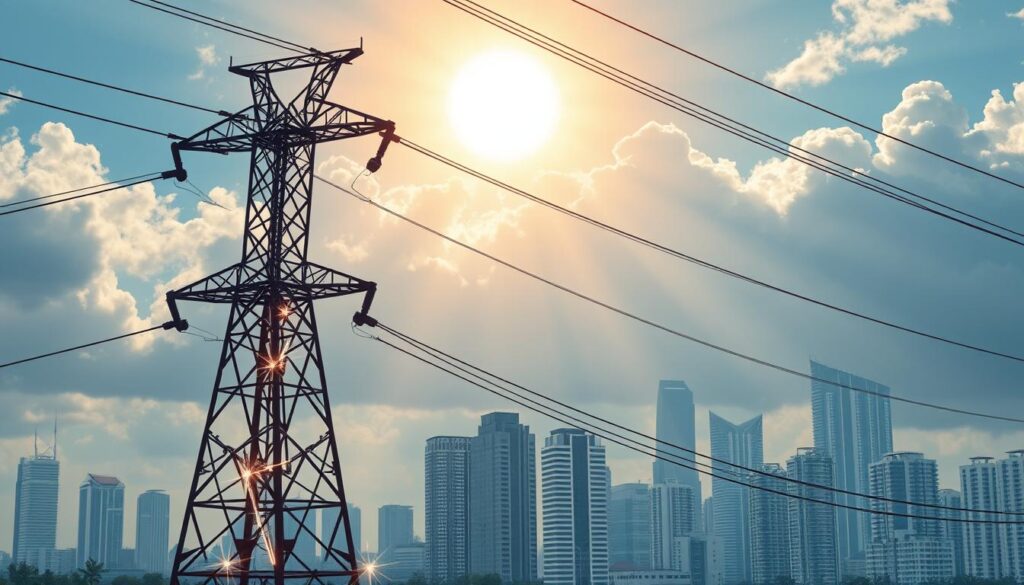
How are electricity tariffs calculated?
Tariffs are broken down into four main components: energy costs, network charges, market support services (MSS), and operations. For Q1 2021, the breakdown was as follows:
- Energy: 21.36¢/kWh (reflects natural gas prices)
- Network: 6.46¢/kWh (covers infrastructure maintenance)
- MSS: 0.23¢/kWh (supports market operations)
- Operations: 0.07¢/kWh (administrative costs)
Natural gas prices significantly impact energy costs, as it is the primary fuel source. Additionally, a 9% GST is applied to the base tariff, increasing the final rate.
Current electricity rates for 2021
In 2021, the regulated tariff was 30.65¢/kWh, including GST. This was higher than the average OEM rate of 28.87¢/kWh, highlighting the savings potential of switching providers. For example, a 4-room HDB flat consuming 365kWh would pay $111.87 with SP Group but only $105.38 with an OEM retailer.
| Property Type | Average Monthly Bill (2021) |
|---|---|
| 1-room HDB | $43.52 |
| 4-room HDB | $111.87 |
| Bungalow | $671.24 |
Wholesale market rates can fluctuate widely, ranging from 0.069¢ to $4.42/kWh. This volatility underscores the importance of fixed-rate plans for budgeting. Additionally, the transmission loss factor (TLF) of 1.03493 and carbon tax are added to your bill, increasing overall costs.
SP Group reviews tariffs quarterly, adjusting them based on market conditions. Compared to regional rates, Singapore’s tariffs are higher than Malaysia’s (16.05¢/kWh) but lower than Thailand’s (34.12¢/kWh). Understanding these factors can help you make informed decisions about your energy consumption.
Types of Electricity Plans Available in Singapore
Consumers in Singapore now have a variety of energy options to choose from. Whether you prefer stability, discounts, or flexible usage, there’s a plan to suit your needs. Let’s explore the main types of price plans available.
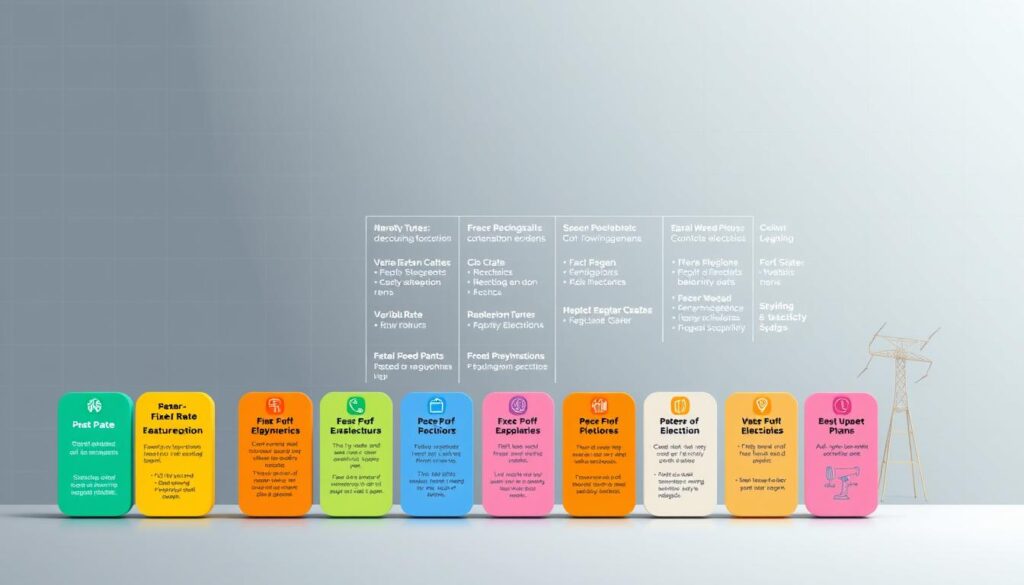
Fixed Price Plans
Fixed price plans offer stability by locking in a rate for the duration of your contract. This is ideal for those who want predictable monthly bills. For example, Geneco’s 24-month plan charges 28.87¢/kWh, while PacificLight’s 36-month plan offers 28.44¢/kWh.
These plans are perfect for budgeting, as they protect you from market fluctuations. However, early termination fees (around $200) may apply if you switch providers before the contract ends.
Discount Off Regulated Tariff (DORT) Plans
DORT plans provide a percentage discount off the regulated tariff. PacificLight’s Classic 60 plan, for instance, offers a 3% discount plus an additional 5% for prompt payment. This can lead to significant savings over time.
These plans are exclusive to PacificLight and require a 60-month commitment. They’re a great choice for long-term savings, especially if you don’t mind a longer contract.
Peak and Off-Peak Plans
Peak and off-peak plans charge different rates based on the time of day. For example, Senoko offers lower rates during off-peak hours, making it ideal for night-shift workers. PacificLight’s timing differs slightly, so compare options to find the best fit.
These plans require a smart meter to track usage. While they can save money for those with flexible schedules, they may not suit everyone’s lifestyle.
By understanding these price plans, you can make an informed decision that aligns with your energy needs and budget. Explore your options and choose wisely!
Comparing Electricity Retailers in Singapore
With multiple options available, selecting the right electricity retailer can make a big difference in your monthly expenses. Each provider offers unique benefits, from rebates to exclusive promotions. Let’s dive into the top retailers and their standout features.
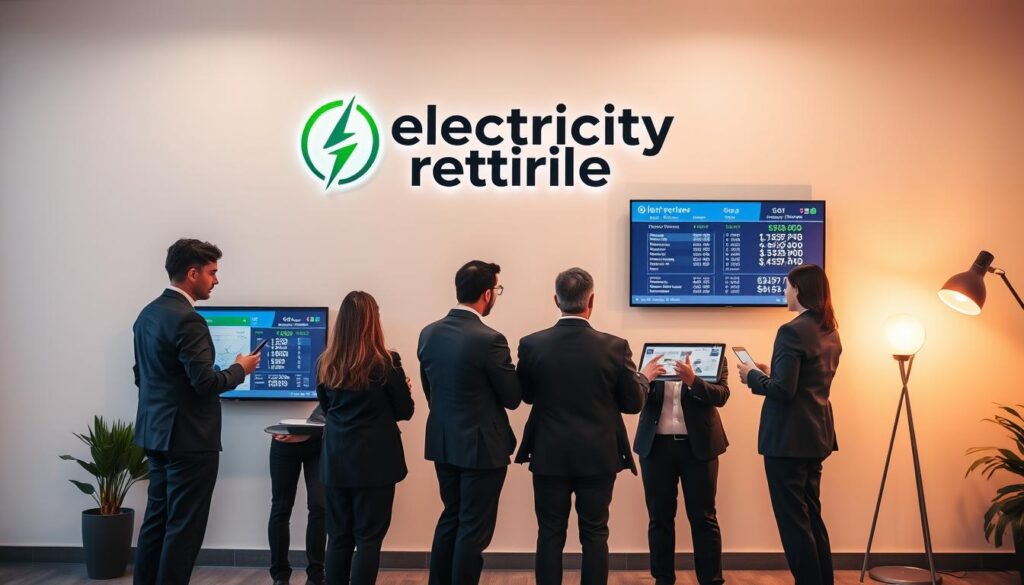
Top Electricity Retailers in 2021
In 2021, several retailers stood out for their competitive offerings. Geneco, PacificLight, and Tuas Power were among the most popular choices. These providers not only offered lower rates but also added perks like rebates and freebies.
Key Features of Each Retailer
Here’s a closer look at what each electricity retailer brings to the table:
- Geneco: Known for its $158 rebates and $20 eCapitaVoucher, Geneco also offers a referral program that pays $20 for every successful referral.
- PacificLight: This provider offers $188 rebates and KrisFlyer miles. They also have credit card partnerships with DBS and Maybank for additional savings.
- Tuas Power: Tuas Power provides free 12-month insurance and special benefits for BTO homeowners, making it a great choice for new families.
Other notable mentions include Senoko, which offers appliance promotions like air fryers and steamers, and Sembcorp, which bundles MyRepublic broadband services with their power plans. Keppel also stands out with UOB card recurring payment bonuses.
When comparing providers, it’s important to consider factors like green energy commitments and whether they charge for transmission loss factors (TLF). Some retailers also offer bill consolidation options, simplifying your monthly payments.
By understanding these features, you can choose a provider that not only reduces your bill but also aligns with your lifestyle and preferences.
How to Choose the Best Electricity Plan for Your Needs
Selecting the right energy option requires understanding your household’s unique needs. By evaluating your electricity consumption and aligning it with the right plan, you can save significantly on your monthly bills. Let’s break down the steps to make this process easier.
Assessing Your Electricity Consumption
Start by reviewing your SP Group usage history. This will give you a clear picture of your monthly electricity consumption. For example, a 4-room HDB flat typically uses around 365kWh, costing about $105.38 per month.
If you live in a terraced house, your usage might be higher, averaging 851kWh or $260.83 monthly. Understanding these numbers helps you estimate your annual cost and choose a plan that fits your budget.
Matching Your Needs with the Right Plan
Once you know your usage, it’s time to match it with the right plan. Here’s a quick guide:
- Fixed Plans: Ideal for those who want predictable bills. These lock in a rate for the contract duration.
- DORT Plans: Perfect for high-usage homes, offering discounts off the regulated tariff.
- Peak/Off-Peak Plans: Great for non-traditional schedules, with lower rates during off-peak hours.
Additionally, consider tools like the SP comparison tool and DBS marketplace for detailed insights. Don’t forget to stack promo codes for extra savings!
| Property Type | Average Monthly Usage | Estimated Cost |
|---|---|---|
| 4-room HDB | 365kWh | $105.38 |
| Terraced House | 851kWh | $260.83 |
By following these steps, you can find a plan that meets your needs and maximizes your savings. Happy planning!
Cost Savings: Fixed Price vs. DORT Plans
Choosing between fixed price and DORT plans can significantly impact your monthly expenses. Both options have unique benefits and drawbacks, making it essential to understand which one aligns with your financial goals and usage patterns.
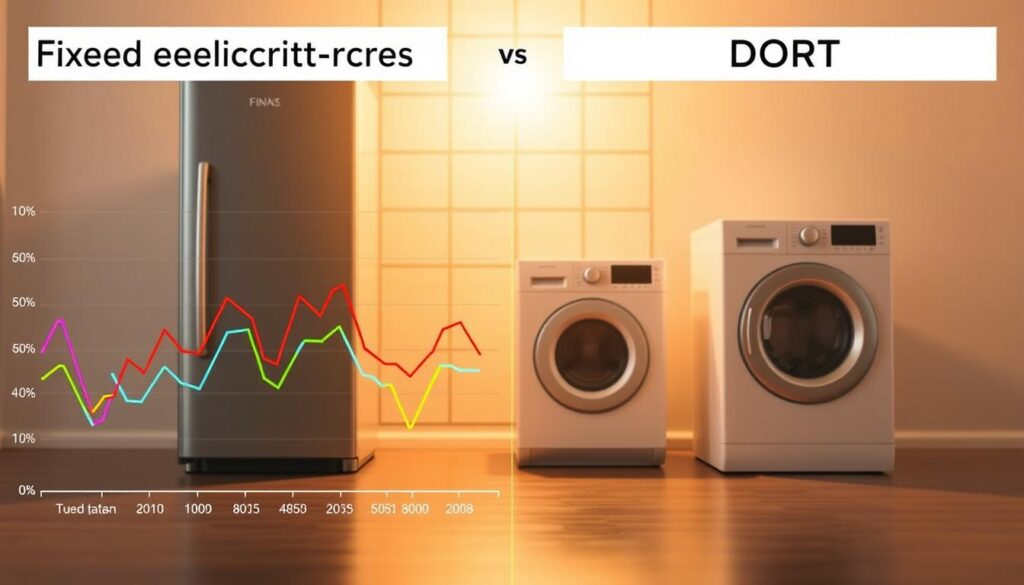
Pros and Cons of Fixed Price Plans
Fixed price plans offer stability by locking in a rate for the duration of your contract. This is ideal for those who want predictable monthly bills, especially during periods of market volatility. For example, in 2021, a 4-room HDB flat could save $105.38 per month with a fixed plan.
However, these plans often come with early termination penalties, typically around $200. Additionally, they may not offer the same level of savings during periods when the regulated tariff drops significantly.
Pros and Cons of DORT Plans
DORT plans provide a percentage discount off the regulated tariff, making them attractive for high-usage households. PacificLight’s DORT plan, for instance, requires GIRO payments but offers automatic savings without the need for constant monitoring.
One downside is the lack of a price ceiling, meaning your bill could increase if the tariff spikes. For example, the 2020 tariff spikes impacted DORT users more than those on fixed plans.
To make an informed decision, consider your usage levels and risk tolerance. Fixed plans are better for conservative users, while DORT plans suit those willing to take on some risk for potential savings. For more insights, check out this comprehensive guide on choosing the right plan.
Tips for Reducing Your Electricity Bill in Singapore
Cutting down on your monthly expenses can start with smarter energy habits. By adopting simple practices and taking advantage of available promotions, you can significantly lower your bill. Here’s how to make the most of your energy usage and savings opportunities.
Energy-Saving Practices for Households
Air conditioning accounts for 40% of home energy usage, according to NEA 2021 stats. Upgrading to an inverter AC can reduce consumption by up to 30%. Smart plugs are another great tool, helping you monitor and control usage in real-time.
Switching to LED bulbs instead of halogen can save up to 80% on lighting costs. Additionally, NEA offers energy-saving grants for households to upgrade appliances. These small changes can add up to big savings per month.
Taking Advantage of Promotions and Discounts
Many retailers offer attractive promotions, such as combo deals bundling broadband and energy services. For example, Sembcorp provides MyRepublic broadband with their energy plans. Credit card cashback programs from UOB and OCBC can also stack savings.
Referral bonuses are another way to save. Geneco offers up to $888 for successful referrals. Join referral code exchange communities to maximize these opportunities. Always check promo expiration dates to ensure you don’t miss out.
| Energy-Saving Upgrade | Estimated Monthly Savings |
|---|---|
| Inverter AC | $15-$20 |
| LED Bulbs | $5-$10 |
| Smart Plugs | $3-$5 |
Timing your bill payments can also help. Seasonal discounts are often available during off-peak periods. Additionally, check if you’re eligible for GST vouchers, which can further reduce your expenses.
By combining these strategies, you can make a noticeable difference in your energy costs. Start implementing these tips today and enjoy the savings!
How to Switch to a New Electricity Provider
Making the switch to a new energy provider is easier than you might think. With the right steps and preparation, you can enjoy better rates and improved services without hassle. Here’s a guide to help you through the process.
Steps to Switch Your Provider
Switching your provider involves a few straightforward steps. First, gather the necessary documents, including your NRIC and SP account number. These are essential for verifying your identity and account details.
Next, compare options online or through an agent-assisted sign-up. Online platforms often provide quick comparisons, while agents can offer personalized advice. Once you’ve chosen a provider, create a Market Support Services (MSS) account to ensure a smooth transition.
Finally, track your switch date to ensure you don’t miss out on any promotions. Activation typically takes about one week, so plan accordingly.
What to Consider Before Switching
Before making the switch, there are a few key factors to keep in mind. First, check for any early termination fees if you’re breaking an existing contract. These can add up, so factor them into your decision.
Also, verify if your new provider includes transmission loss factors (TLF) and carbon tax in their rates. Some retailers may charge additional fees, so read the fine print carefully.
Additionally, research the stability of the retailer. For example, the exit of Hyflux in 2019 left many customers in a difficult position. Choose a provider with a strong track record to avoid similar issues.
Lastly, consider smart meter installation fees if your chosen plan requires one. These can vary, so ask your provider for details upfront.
- Step-by-Step Switching Guide: Gather documents, compare options, and create an MSS account.
- Required Documents: NRIC and SP account number.
- Online vs Agent-Assisted Sign-Ups: Choose the method that suits your needs.
- Early Termination Costs: Calculate potential fees before switching.
- Retailer Stability: Research the provider’s reputation and history.
Common Mistakes to Avoid When Choosing an Electricity Plan
Navigating energy options can be tricky, especially when hidden costs are involved. Many consumers overlook key details, leading to unexpected charges and frustration. By understanding common pitfalls, you can make smarter decisions and save money.
Overlooking Hidden Fees
Hidden fees can add up quickly if you’re not careful. For example, paper bills often come with a $3 charge, while late payments may incur a 1.5% penalty. Additionally, the AMI meter fee is $40 before GST, which many providers don’t highlight upfront.
Here are 12 hidden charges to watch out for:
- Transmission Loss Factor (TLF)
- Market Development and Systems Charge (MDSC)
- Carbon tax
- Early termination fees
- Smart meter installation costs
- Auto-renewal penalties
- Bundled service requirements
- Referral bonus eligibility periods
- Promotional rate expiration
- Free gift terms and conditions
- GIRO vs credit card payment differences
- Complaint histories on CASE
Not Reading the Fine Print
The fine print often contains critical details that can impact your contract. For instance, promotional rates may expire quickly, reverting to higher charges. Auto-renewal clauses can also trap you into extended commitments without notice.
Always verify the following before signing up:
| Item | Details to Check |
|---|---|
| Early Exit Fees | Compare across retailers |
| Payment Methods | GIRO vs credit card differences |
| Promotions | Expiration dates and conditions |
“Always read the fine print. What seems like a great deal might have hidden costs that outweigh the benefits.”
By avoiding these common mistakes, you can choose a plan that truly meets your needs and budget. Take the time to research and ask questions—it’s worth the effort!
Conclusion: Finding the Best Electricity Plan Singapore 2021
Making informed energy decisions can lead to significant savings and better service. Options like Geneco’s 24-month plan and PacificLight’s DORT offer tailored solutions for different needs. With potential savings of over $500 annually, it’s worth exploring these choices.
Before committing, check user reviews on platforms like Seedly for real-world insights. Regularly reviewing your energy strategy every six months ensures you stay on top of the best deals. For those comfortable with market fluctuations, SP’s wholesale option might be worth considering.
Avoid long-term lock-ins, especially 60-month contracts, unless they align with your long-term goals. Always verify details like TLF and hidden fees to avoid surprises. Use comparison tools to evaluate options based on your usage patterns and preferences.
By staying informed and proactive, you can maximize your savings and enjoy reliable service. Start your comparison today and take control of your energy costs!


